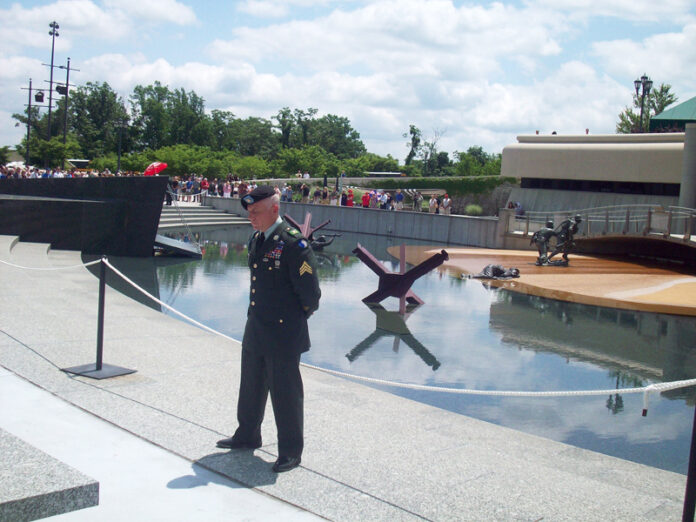
Veterans of the fateful campaign joined thousands of others as the National D-Day memorial in Bedford held a 65th anniversary observance Saturday. The 29th Army Division Band played, and speaker after speaker came to the podium, reading the words written by D-day veterans, which were eyewitness accounts of the Allied landing at Normandy, France, in 1944.
Congressman Bob Goodlatte (R-Roanoke) remembered a day more than a decade ago, when the idea for a National D-Day Memorial in Bedford took hold.
“[On] the 53rd anniversary of D-Day, the land this memorial stands upon, was set apart from common use in a solemn service of consecration,” Goodlatte said.
National D-Day Memorial Foundation president William McIntosh noted that fewer and fewer veterans are still alive, or able to attend observances at the site, built in Bedford because it reportedly had the highest number of per-capita losses on D-Day of any locality in America.
From the shadow of the commanding “Overlord” arch, (named for the operation’s code name) Bedford area Delegate Lacey Putney spoke the words of President Franklin D. Roosevelt: “they fight not for the lust of conquest, they fight to end conquest. They fight to liberate, they yearn but for the end of battle and a return to the haven of home.”
“Complete unity prevails throughout the Allied army,” British Prime Minister Winston Churchill told a radio audience on D-Day. Churchill’s words were repeated by author Alex Kershaw. “The Bedford Boys,” Kershaw’s book is being made into a movie.
“There is a brotherhood of arms between us and our friends in the United States,” said Churchill/Kershaw.
Richard Howell recited the account of Private A. Baker, who wound up on Gold Beach in Normandy: “if you could make it to the wall you were safe for a time at least, from enemy fire, but so many of our fine young men did not make it.”
Before and after the proceedings, D-Day veterans gathered in groups or reacquainted themselves with men they may not have seen since June 6, 1944. M.H. Green was on the U.S. Rich that day as a Navy seaman. He still vividly remembers “men getting blown out of the water …black smoke, and the smell, a torpedo going under [the ship] that night, a whole lot.”
After the solemn ceremony, McIntosh asked those present (estimated at some 4,000) to recognize the D-Day veterans in attendance; many had not seen each other for decades, or since D-Day, and came to Bedford from all corners of the country. Roanoke resident and D-Day veteran Bob Slaughter was among those who took part in a wreath-laying ceremony; Slaughter is widely credited with getting the project off the ground.
A move to have the memorial placed under the auspices of the National Park Service is afoot, due to debt associated with the Foundation’s annual operating costs of $2 million-plus.

